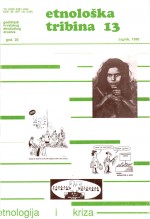Inflacija u karikaturama "Ošišanog ježa"
Inflation in the "Ošišani jež" Cartoons
Author(s): Gordana LjubojaSubject(s): Politics, Economy, Media studies, Cultural Anthropology / Ethnology, Culture and social structure , Post-War period (1950 - 1989)
Published by: Hrvatsko etnološko društvo
Keywords: inflation; Ošišani jež; cartoon; social and economic status; everyday life's problems;
Summary/Abstract: The paper deals with the phenomenon of inflation reflected through the medium of newspaper cartoons. Dew to its particular qualities as a genre, cartoons have probably left the most inclusive testimony of cultural, as well as psychological responses to the stressful and devastating process of economic disruption. Cartoons were being published throughout the period of rampant inflation 1988-1989, getting more numerous and intense as the crisis approached its climax towards the end of the year 1989. Some 400 cartoons issued in the well-known weekly magazine for humor and satire »Ošišani jež« have been examined for the purpose. Specific themes, metaphors, motives and symbols most often used have been analysed. The majority of cartoons are conceived in the form of a dialogue and look more like »illustrated jokes«. Certain number, however, represent metaphorical ideograms with less obvious and direct message. The central them » varied in a number of ways are those of hunger and frustration caused by impoverishment and abrupt downfall in social and economic status. Bread as a symbol of basic human needs and meat as a symbol of expected and formerly owned surplus are widely used. The main protagonists of the cartoons are laborers, beggars and retired people, all social categories dependent on regular and, under the circumstances, insufficient income. The other strata, like peasants, are represented only rarely and then with the stress on their allegedly better position. Striking is the lack of critical interest for commenting on growing social inequalities that came as a result of escalating inflation. Few cartoons comment on the current political events either. The focus is narrowed down on the problems of stark everyday living. Fictitious unbounded adaptability of people that cope happily with less than elementary living conditions is a general source of ironic remarks. With the passing of time and further aggravation of the crisis the shift toward bitter moods and rather explicit treatment of the same topics can be noticed. Black humor is exploited more often and less effort is put in the construction of comical effects.
Journal: Etnološka tribina : Godišnjak Hrvatskog etnološkog društva
- Issue Year: 20/1990
- Issue No: 13
- Page Range: 73-78
- Page Count: 6
- Language: Serbian

